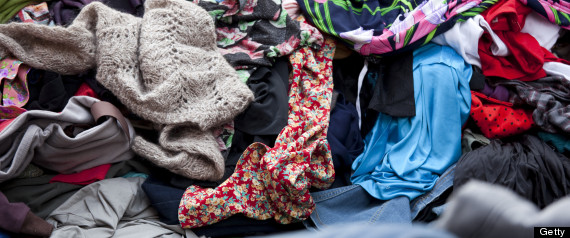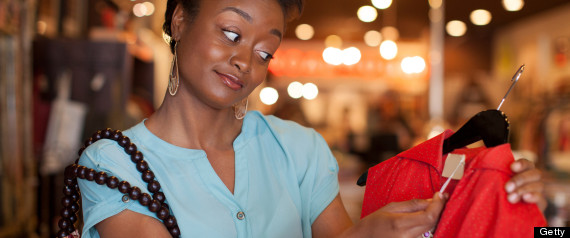Many of us can't get enough of "fast fashion" -- hyper-trendy clothing that moves from catwalk to retail floor at breakneck speed. While this is great for you rarely having to wear the same outfit, there are some serious implications of consuming clothes in ever-increasing volumes. What happens when you're sick of your bedazzled loafers or upset that your $10 jeans are starting to wear out?
You likely turn to thrift shops. But are all of our discarded novelty tees and color-block cardigans really doing our favorite secondhand shops any favors? We set out to answer that question.
Thrift shops receive more clothes than they know what to do with.

We love getting new stuff. According to the Council for Textile Recycling, the U.S. generates around 25 billion pounds of brand-new textiles per year (around 85 percent of that eventually heads for landfills). Goodwill, Salvation Army and other secondhand stores get the remaining 15 percent, which certainly adds up.
One New York City Salvation Army store received about five tons per day in 2012. Last year, Salvation Army locations across the country took in 80 million pounds of clothing overall, according to Tim Raines, marketing manager for the organization. While stores aren't exactly complaining -- there are other avenues for excess textiles than resale stores, after all -- the sheer volume of discarded, yet still wearable, fashions illustrates the way we view clothing these days: totally disposable.
Many of those clothes are items that were on-trend as recently as last season.

"You get a clear sense of the overconsumption prevalent in most of the United States by frequenting thrift stores," Susan Choi, who operates an Etsy shop for vintage clothing, told The Huffington Post. "It's common to find items that were in trend only a year or two ago," she wrote, "and a vast quantity of them."
Maybe we just can't help ourselves because clothing has gotten so insanely cheap. Back in 1901, the average household might spend 14 percent of its annual income on clothing, and now it's just over three percent. It makes more sense for us to buy new instead of repairing or altering our old stuff -- indeed, between 1900 and 2013, tailors in the U.S. declined from nearly 230,000 to just 21,400.
Erick Martinez of ARC Thrift Stores says that from the operations side, that's both a blessing and a curse. "Today's fast fashion does tend to show its wear sooner," he said.
When there are too many clothing donations, items are turned into rags or end up in landfills.

As much as 80 percent of all donations to charity thrift stores are reclaimed by textile recyclers, a portion of which becomes wiping rags or polishing cloths, the executive director of Secondary Materials and Recycled Textiles (SMART), a trade organization, told NPR. Unsurprisingly, the rag industry is a booming -- and cutthroat -- business that doesn’t totally behoove the secondhand industry. Certain street-side bins and for-profit used clothing recycling ventures take donations that may otherwise have gone to thrift stores, so some items might head to the shredder instead of the racks.
To be fair, the rag industry also helps thrift shops. Even if donations can't be sold in their stores, at least the organization may profit slightly by selling them for other uses and, in the case of charities, pass on that revenue to people in need. In 2013, the U.S. exported about 860,000 tons of secondhand apparel to other countries, according to Department of Commerce stats. It typically gets packed into large bales, sorted by the condition it's in and sold at markets -- sometimes for more than the U.S. thrift store asking price.
Fast fashion is even competing with thrift stores.

Some stores say an influx of recent trends helps them remain relevant in the eyes of consumers. But when customers can buy new and even more current styles for around the same price as used, why go thrift shopping at all?
"Forever 21 is not great news for us," Bill Gover, vice president of merchandising and production at the NYC-based Housing Works, told HuffPost. In fact, such stores are competition. Many fast fashions end up at the organization's warehouse where, for $25, customers pack whatever they can into a bag. (Goodwill has a similar operation in Texas, where excess clothing is sent to Goodwill's Blue Hangar store where customers sort through massive bins.) To compete, Gover explained, he's trying to teach employees to look out for "on-trend" vintage -- older items that line up with current fashion trends and can fetch a slightly higher price because they're better made.
Elizabeth Cline, author of “Overdressed: The Shockingly High Cost Of Cheap Fashion," lamented that, no matter the manufacturer, our view of clothing needs to change. "No matter where consumers shop, even if it's an H&M," Cline told The Huffington Post, "I think the key is not thinking of clothing as disposable. Clothing has a life cycle and we have to take responsibility for it."
Correction: The title of Elizabeth Cline's book has been amended from “Overdressed: The Shockingly High Cost Of Fast Fashion" to “Overdressed: The Shockingly High Cost Of Cheap Fashion." Language was also amended so as not to suggest all excess secondhand clothing is shredded. We apologize for the oversight.

